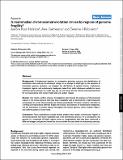Por favor, use este identificador para citar o enlazar a este item:
http://hdl.handle.net/10261/1423COMPARTIR / EXPORTAR:
 SHARE SHARE
 CORE
BASE CORE
BASE
|
|
| Visualizar otros formatos: MARC | Dublin Core | RDF | ORE | MODS | METS | DIDL | DATACITE | |

| Campo DC | Valor | Lengua/Idioma |
|---|---|---|
| dc.contributor.author | Ruiz-Herrera, Aurora | - |
| dc.contributor.author | Castresana, José | - |
| dc.contributor.author | Robinson, Terence J. | - |
| dc.date.accessioned | 2007-05-08T13:53:24Z | - |
| dc.date.available | 2007-05-08T13:53:24Z | - |
| dc.date.issued | 2006-12-08 | - |
| dc.identifier.citation | Genome Biology 2006, 7:R115 | - |
| dc.identifier.issn | 1465-6914 | - |
| dc.identifier.uri | http://hdl.handle.net/10261/1423 | - |
| dc.description.abstract | [Background] A fundamental question in comparative genomics concerns the identification of mechanisms that underpin chromosomal change. In an attempt to shed light on the dynamics of mammalian genome evolution, we analyzed the distribution of syntenic blocks, evolutionary breakpoint regions, and evolutionary breakpoints taken from public databases available for seven eutherian species (mouse, rat, cattle, dog, pig, cat, and horse) and the chicken, and examined these for correspondence with human fragile sites and tandem repeats. | en |
| dc.description.abstract | [Results] Our results confirm previous investigations that showed the presence of chromosomal regions in the human genome that have been repeatedly used as illustrated by a high breakpoint accumulation in certain chromosomes and chromosomal bands. We show, however, that there is a striking correspondence between fragile site location, the positions of evolutionary breakpoints, and the distribution of tandem repeats throughout the human genome, which similarly reflect a non-uniform pattern of occurrence. | - |
| dc.description.abstract | [Conclusion] These observations provide further evidence that certain chromosomal regions in the human genome have been repeatedly used in the evolutionary process. As a consequence, the genome is a composite of fragile regions prone to reorganization that have been conserved in different lineages, and genomic tracts that do not exhibit the same levels of evolutionary plasticity. | - |
| dc.language.iso | eng | en |
| dc.publisher | BioMed Central | - |
| dc.relation.isversionof | Publisher's version | - |
| dc.rights | openAccess | en_US |
| dc.subject | Comparative genomics | en |
| dc.subject | Genome evolution | en |
| dc.subject | Mammalian | en |
| dc.subject | Eutherian species | en |
| dc.title | Is mammalian chromosomal evolution driven by regions of genome fragility? | en |
| dc.type | artículo | en |
| dc.identifier.doi | 10.1186/gb-2006-7-12-r115 | - |
| dc.description.peerreviewed | Peer reviewed | en_US |
| dc.identifier.pmid | 17156441 | - |
| dc.type.coar | http://purl.org/coar/resource_type/c_6501 | es_ES |
| item.openairetype | artículo | - |
| item.grantfulltext | open | - |
| item.cerifentitytype | Publications | - |
| item.openairecristype | http://purl.org/coar/resource_type/c_18cf | - |
| item.fulltext | With Fulltext | - |
| item.languageiso639-1 | en | - |
| Aparece en las colecciones: | (IBMB) Artículos | |
Ficheros en este ítem:
| Fichero | Descripción | Tamaño | Formato | |
|---|---|---|---|---|
| gb-2006-7-12-r115.pdf | 389,64 kB | Adobe PDF |  Visualizar/Abrir |
CORE Recommender
PubMed Central
Citations
71
checked on 14-abr-2024
SCOPUSTM
Citations
124
checked on 21-abr-2024
WEB OF SCIENCETM
Citations
119
checked on 23-feb-2024
Page view(s)
484
checked on 22-abr-2024
Download(s)
214
checked on 22-abr-2024
Google ScholarTM
Check
Altmetric
Altmetric
Artículos relacionados:
NOTA: Los ítems de Digital.CSIC están protegidos por copyright, con todos los derechos reservados, a menos que se indique lo contrario.
